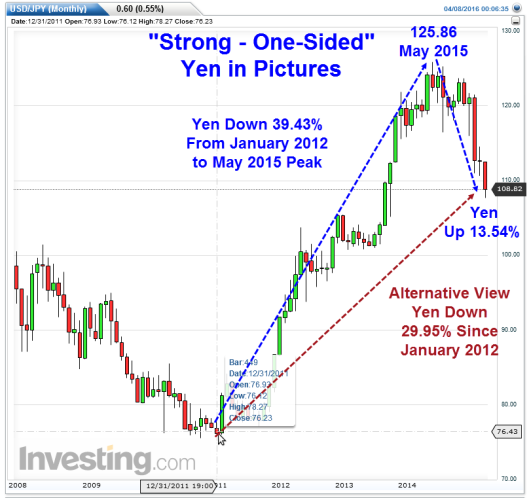Japan is angry. Rightfully so, in a perverse way.
What is Japan angry about?
It has not succeeded in destroying its own currency, a seemingly simple task.
Japan Lashes Out
My advice is coming up. First, please consider Japan Lashes Out Against Rise of Yen:
The yen touched new highs on Thursday, defying Tokyo’s effort to weaken the Japanese currency in the latest sign that policymakers in leading economies are running out of tools to kick-start sagging growth and battle the threat of deflation.
Japanese officials issued warnings about “one-sided” moves, a signal of possible intervention that would usually put traders on high alert. Instead, the yen soared to its highest levels since the Bank of Japan fired its second stimulus bazooka in October 2014.
The yen’s momentum comes despite the Herculean efforts undertaken by central banks to spur growth in Asia and Europe. Like the BoJ, the European Central Bank has intervened in the capital markets at unprecedented levels to little effect.
Their task is being made harder by US Federal Reserve Chair Janet Yellen, who has signalled a slower pace of interest-rate increases than was indicated in December, triggering a weaker dollar.
Brexit fears are, meanwhile, weighing on the pound, diluting the effect of BoJ and ECB measures on exchange rates with their major trading partners.
Blame the Yen
It’s pretty damn pathetic when you cannot destroy your own currency. But that’s where we are, given the competitive currency devaluation madness.
In addition to the Bank of Japan and Prime Minister Shinzo Abe, corporations are not pleased with recent results.
For example, ZeroHedge reports that Asia’s Largest Clothing Retailer Plummets After Slashing Guidance By A Third; Blames Strong Yen.
Strong “One-Sided” Yen
Given claims of “strong” and “one-sided” moves in the yen, Mish readers no doubt would like to examine that idea in pictures.
Up arrows in the following chart represent weakening of the yen vs. the dollar, and down arrows strengthening. Captions explain by how much.

Strong “One-Sided” Yen Synopsis
- From January 2012 until the tip of the decline in May 2015, the yen declined 39.43% vs. the US dollar
- Since then, the yen has gained 13.54%
- Alternatively, using the same starting point of January 2012, the yen is down a mere 29.95% vs. the US dollar
- Supposedly, this is one-sided “strength”
How one-sided can you get going down while complaining about going up?
Through the Looking Glass
“Well, in our country,” said Alice, still panting a little, “you’d generally get to somewhere else—if you run very fast for a long time, as we’ve been doing.”
“A slow sort of country!” said the Queen. “Now, here, you see, it takes all the running you can do, to keep in the same place. If you want to get somewhere else, you must run at least twice as fast as that!”
Mish Advice
If you cannot destroy your own currency, don’t blame others with “one-sided” complaints. Just try harder.
Down 39.43 is clearly insufficient. Down a mere 29.95% is an outright pathetic performance.
Japan, we know you can do it. Give it all you’ve got.
My advice of the day, at no charge: Try harder. Set a goal of down 80% and “do whatever it takes!”
